
The mother of a 7-month old boy was worried about a nontender, firm, irreducible lump that appeared on his navel 2 months ago.

The mother of a 7-month old boy was worried about a nontender, firm, irreducible lump that appeared on his navel 2 months ago.
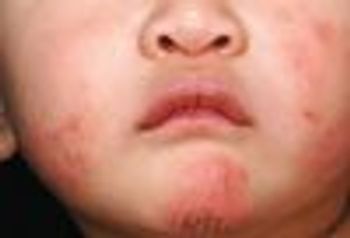
A 9-month-old boy has had a pruritic facial rash that has resisted topical therapy. Another9-month-old boy has had a similar rash, with no response to topical therapy. Both infants have the same condition and a family history of atopy.

A 26-month-old girl presented to the general nephrology clinic for evaluation of chronic renal insufficiency. During the examination, the physician noted green discoloration of the teeth.

This 16-year-old boy with nailpatella syndrome (NPS) presented for routine follow-up. As an infant, he had surgical correction for clubfeet. For the past month, he had had intermittent bilateral foot and ankle pain and some knee and hip discomfort.
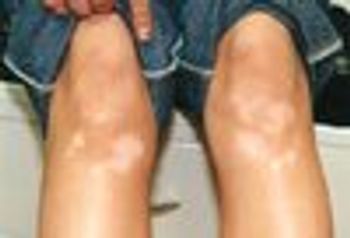
This 16-year-old boy had slowly progressive hypopigmented lesions onthe lower extremities for the past 4 years. He also had atopic dermatitis,asthma, and allergic rhinitis.

You are asked to evalute a fussy 6-week-old infant with a rash that started on her left axilla 3 weeks ago and spread to the left arm, chest, and abdomen.

My 18-month-old son has had a diaper rash, with no other symptoms, within a few days of eating a poached egg on 3 separate occasions.

Vaccination against infectious diseases has saved millions of lives. The recurrent threat of influenza pandemics and the prevalence of global HIV infections underscore the need for better-designed, more effective vaccines.

This 14-year-old boy is brought for assessment and treatment of acne by his mother who is noted to have superficial acne scars. His 17-year-old brother has required systemic isotretinoin to control his acne, and the mother wishes to avoid any systemic therapy for her other son.

This 9–month–old boy was initially evaluated at age 6 weeks for an extensive eczematous rash on the head and antecubital and diaper areas and blood and mucus in the stool with each diaper change over a 2– to 3–week period. The symptoms were attributed to milk allergy, and the infant’s formula was changed. At 8 weeks of age, a petechial rash developed on the boy’s trunk and legs. His symptoms persisted despite multiple formula changes, and he was referred to the emergency department.

A 6-month-old boy with different colored eyes since birth. The parents are concerned that the eye anomaly may be associated with an underlying condition after reading about eye disorders online.

A 13-year-old boy from inner city Philadelphia presented with an infected “tattoo” on his right forearm. On examination, he had multiple hypopigmented scars on his extremities. When asked about the scars, the patient appeared embarrassed and stated that they were tattoos, which he created with an eraser from a pencil.

The mother of a healthy 21-month-old girl says that her daughter's unruly hair never lies flat on the scalp and cannot be tamed by combing or brushing.
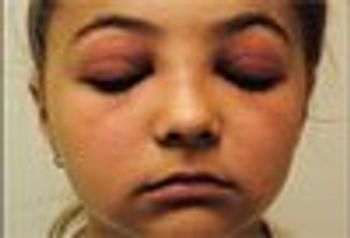
This 8-year-old girl has had swollen, red eyelids for the past 24 hours. She denies pain or pruritus. She has had no eye drainage, fever, or other systemic signs of illness. She reports some mild fatigue for the past few months but denies myalgias or decreased muscle strength.

A 10-year-old boy had increasing irritation and itching of the lower legs for the past 5 weeks. The boy was an avid soccer player. Examination revealed an acutely inflamed, exudative dermatitis on the anterior aspect of both legs.

For 3 days, a 10-year-old boy had an itchy, tense, vesicular rash on the fingers of both hands (A). He was otherwise healthy.

This 14-month-old girl was brought for evaluation of marked swelling and erythema of the left eyelids (A) The mother had noticed a green discharge and mild swelling of the eye 2 nights earlier.

An 11-day-old African American boy was brought in for a well-baby visit. Pregnancy, labor, and delivery had been uncomplicated.

I read with interest Drs Kumar, Noronha, and Leung's recent "What's Your Diagnosis?" case highlighting the common skin problem, keratosis pilaris. In my suburban pediatric practice, patients frequently ask me how to eradicate this benign but annoying condition.
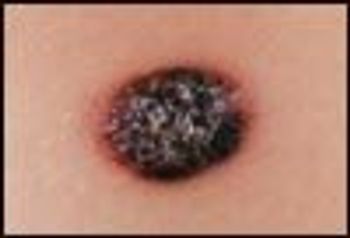
This pigmented lesion has developed over the past 12 months on the posterior aspect of a 3-year-old boy's thigh. The lesion measures 5 mm and exhibits a dark black nodular center with a light brown pigmented periphery. The lesion is asymptomatic, and the child is well.

Identification of this disorder can be difficult because of the wide range of effects of prenatal alcohol exposure. Here: tips on how to recognize its clinical manifestations and neurodevelopmental features and behaviors.

A baby boy, aged 14 days, presented with a temperature of 38.2°C (100.8°F), a generalized maculopapular rash, and purulent otorrhea. He was treated with oral amoxicillin for 10 days. At age 25 days, he again presented-this time with erythema and edema of the umbilicus, thrush, and fever of 24 hours’ duration.

A discussion of three types of Genital Lesions: Sebaceous Gland Hyperplasia of the Penis, Varicocele, and Penile Dog Bite.

A 4-month-old girl is brought to your office by nervous parents who point out swelling of all the fingers of her right hand associated with tender, deep nodules on the proximal and middle phalanges.
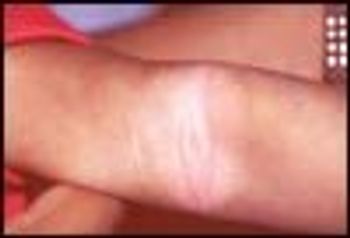
The areas of hypopigmentation on this 4-month-old girl are sequelae of eczema. The rash had developed on the infant’s upper extremities in the bilateral antecubital and popliteal fossae at 1 month of age. Her cheeks were also affected, although only slightly. Her initial diet consisted of regular infant formula. This was switched to soy formula, which she vomited. She was then given a lactose-free formula, which she tolerated well.